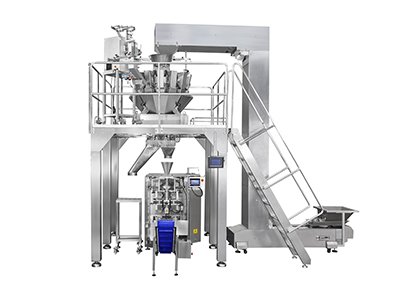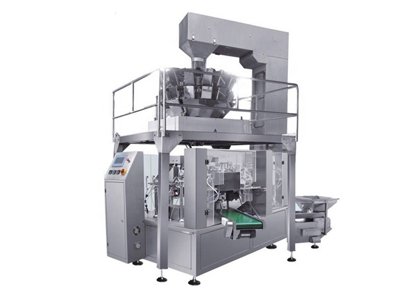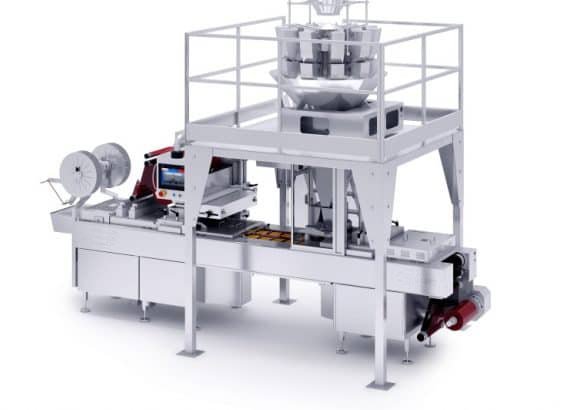Frozen foods packaging machines are essential in today’s food production industry, as the frozen food packaging needs are going up, they ensure that frozen foods are packaged efficiently and effectively with advanced frozen food packaging technologies. These machines come in various designs and sizes to suit different needs and requirements, and they can be used for packaging a wide range of frozen foods, including frozen peas, vegetables, frozen burritos fruits, chicken nuggets, meats, seafood, frozen meals and more. In this guide, we will explore the different types of frozen food packaging machines and what you need to know to select the right one for your needs.
What Are The Types of Frozen Food Packaging Machines?
1. Vertical Form Fill Seal (VFFS) Machine

Vertical baggers are the most commonly used type of frozen food packaging machines. They are versatile and can handle a wide range of frozen foods. They work by forming pillow pouches from a roll of laminated or polyethylene materials film, filling them with the frozen food, and sealing it. Vertical bagging machines are highly automated, making them ideal for high-volume production.
2. Horizontal Form Fill Seal (HFFS) Machine

HFFS machines also called horizontal flow pack machines or flow wrappers, they are similar to VFFS machines, but they work horizontally They are commonly used for packaging frozen food products that are not suitable for vertical packaging. HFFS machines work by forming a pouch from a flat sheet of film, filling it with the frozen food, and sealing it.
3. Premade Pouch Packaging Machine

Premade pouch packaging solutions are another commonly used for seafood with stand up bags or stand up pouches. They equipped with multihead weighers to make the packing process fully automatic: automatically open bags, weighing and fill products, seal pouches and output.
4. Thermoforming Machine

Thermoforming machines are designed to package frozen foods in rigid trays. They work by heating a sheet of plastic, which is then molded into a tray shape. The frozen food is then placed into the tray, and a lid is heat-sealed onto the top of the tray.
5. Tray Sealer

Tray sealers are used to package frozen foods in pre-made trays. They work by placing the frozen food into the tray and then sealing the tray with a plastic film. Tray sealers are ideal for low-volume production, as they can be operated manually or with a semi-automatic machine.
What Are The Factors to Consider When Selecting a Frozen Food Packaging Machine?
1. Type of Frozen Food
The type of frozen food you want to package will determine the type of packaging machine you need. For example, if you want to package frozen vegetables, a VFFS machine may be suitable. However, if you want to package frozen meats, a thermoforming machine or vacuum sealer may be more appropriate.
2. Production Volume
The production volume will also determine the type of machine you need. If you have a high-volume production, a VFFS machine or thermoforming machine may be the best option. However, if you have a low-volume production, a tray sealer or vacuum sealer may be more suitable.
3. Available Space
The size of the packaging machine and the space available in your production facility are also important factors to consider. Make sure you choose a machine that will fit comfortably in your space and will not hinder the movement of other equipment or workers.
4. Cost
The cost of the packaging machine is another factor to consider. Make sure you choose a machine that fits within your budget but still meets your needs and requirements. It is also important to consider the long-term cost of the machine, including maintenance and repair costs.
5. Packaging Material
If you want to use a roll of film, a VFFS machine or HFFS machine may be more suitable. It is also important to consider the quality and thickness of the packaging material to ensure it provides adequate protection to the frozen food.
6. Additional Features
Additional features such as automatic feeding, weighing, labeling, and date coding can improve the efficiency and accuracy of your packaging process. However, these features may come at an additional cost, so it is important to consider whether they are necessary for your production needs.
7. Maintenance and Service
Proper maintenance and servicing of your frozen food packaging machine are crucial to ensuring its longevity and efficiency. Regular cleaning and inspection can prevent breakdowns and reduce the risk of contamination. It is also important to work with a reputable manufacturer or supplier that provides ongoing support, training, and spare parts.
Conclusion
Choosing the right frozen food packaging machine is critical to ensuring the quality and safety of your frozen food products. Consider factors such as the type of frozen food, production volume, available space, cost, packaging material, and additional features when selecting a machine. Proper maintenance and service can also ensure the longevity and efficiency of your packaging machine. With these considerations in mind, you can select a frozen food packaging machine that meets your needs and helps you produce high-quality frozen food products.
